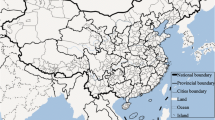Abstract
Cities no longer develop independently but exist in a large city network in the globalization era because of the rapid development of information and communication technologies. Instead of attribute data, relational data has been widely recognized as an improved tool to analyze the importance of a city in a city network. This study attempts to analyze China’s city network based on users’ friend relationships in Sina Weibo, the most popular online social networking service in China. By collecting friend relationship data from 20 users located in the selected 51 cities, a city network is built based on connections in the virtual world. Findings show that although microblog users build friend relationships with other users located almost everywhere, significant variations exist regarding the closeness of such connections. In particular, a limited number of cities accumulate the majority of top connections; the limited number indicates the significant power of these key cities in the city network. These top connections are also highly related to cities located in Eastern China. The regression model demonstrates that a city with a higher of per capita GDP exerts a powerful influence in the city network. Compared with a prefecture-level city, a municipality directly under central government is considerably powerful. Therefore, the importance of a city in the real world has significant influence on the power of that city in the city network based on online social networking connections.




Similar content being viewed by others
Notes
The survey report on the first year of microblog use in China (Zhongguo weibo yuannian shichang baipishu). Assessed 29 December 2014, from http://www.slideshare.net/lxm19871231/ss-5245420.
In this study, China refers to Mainland China, that is, excluding Hong Kong, Macau, and Taiwan. This consideration does not deny these administrative units are integral parts of China. However, Sina Weibo is not popular enough in these regions.
The division of China into Eastern, Central, and Western China can be traced back to the “seventh 5-year plan” in 1986 and have been extensively used thereafter not only in academic research but also in policy making in China’s regional development. Eastern China includes Beijing, Tianjin, Hebei, Liaoning, Shanghai, Jiangsu, Zhejiang, Fujian, Shandong, Guangdong, and Hainan; Central China includes Anhui, Heilongjiang, He-nan, Hubei, Hunan, Jiangxi, Jilin, and Shanxi; and Western China includes Chongqing, Guangxi, Guizhou, Inner Mongolia, Ningxia, Qinghai, Gansu, Shaanxi, Sichuan, Tibet, Xinjiang, and Yunnan.
References
Beaverstock, J. V., Smith, R. G., & Taylor, P. J. (2000). World-city network: A new metageography? Annals of the Association of American Geographers, 90(1), 123–134.
Bonacich, P. (1987). Power and centrality: A family of measures. American Journal of Sociology, 92(5), 1170–1182.
Castells, M. (1996). The rise of the network society. Vol. 1 of The information age: Economy, society and culture. Oxford: Blackwell.
China National Network Information Center. (2011). The 28th Survey Report on Internet Development in China. Statistic Report of China. Beijing: CNNIC.
Derudder, B., & Witlox, F. (2005). An appraisal of the use of airline data in assessing the world city network: A research note on data. Urban Studies, 42(13), 2371–2388.
Fang, C. L. (2011). New structure and new trends of formation and development of urban agglomerations in China. Scientia Geographica Sinica, 31(9), 1025–1034. (in Chinese).
Friedman, T. L. (2006). The world is flat: The globalized world in the twenty-first century (pp. 3–543). London: Penguin.
Goetz, A. R. (1992). Air passenger transportation and growth in the US urban system, 1950–1987. Growth and Change, 23(2), 217–238.
Graham, S., & Marvin, S. (1996). Telecommunications and the city: Electronic spaces, urban places. Hove: Psychology Press.
Gu, C. L., & Pang, H. F. (2008). Study on spatial relations of Chinese urban system: Gravity model approach. Geographical Research, 27(1), 1–12. (in Chinese).
Jenks, G. F., & Caspall, F. C. (1971). Error on choroplethic maps: Definition, measurement, reduction. Annals of the Association of American Geographers, 61(2), 217–244.
Jin, F. J., & Wang, C. J. (2005). Hub-and-spoke system and China aviation network organization. Geographical Research, 24(5), 774–784. (in Chinese).
Malecki, E. J. (2002). The economic geography of the Internet’s infrastructure. Economic Geography, 78(4), 399–424.
Matsumoto, H. (2004). International urban systems and air passenger and cargo flows: Some calculations. Journal of Air Transport Management, 10(4), 239–247.
Mitchelson, R. L., & Wheeler, J. O. (1994). The flow of information in a global economy: The role of the American urban system in 1990. Annals of the Association of American Geographers, 84(1), 87–107.
National Bureau of Statistics. (2011). China city statistic yearbook. Beijing: China Statistic Publishing House.
Sassen, S. (2001). The global city: New York, London, Tokyo. Princeton, NJ: Princeton University Press.
Shearmur, R., & Doloreux, D. (2008). Urban hierarchy or local buzz? High-order producer service and (or) knowledge-intensive business service location in Canada, 1991–2001. The Professional Geographer, 60(3), 333–355.
Shin, K. H., & Timberlake, M. (2000). World cities in Asia: Cliques, centrality and connectedness. Urban Studies, 37(12), 2257–2285.
Sui, D. Z., & Wheeler, J. O. (1993). The location of office space in the metropolitan service economy of the United States, 1985–1990. The Professional Geographer, 45(1), 33–43.
Taylor, P. J. (2004). World city network: A global urban analysis. Hove: Psychology Press.
Taylor, P. J. (2009). Urban economics in thrall to Christaller: A misguided search for city hierarchies in external urban relations. Environment and Planning A, 41(11), 2550–2555.
Taylor, P., Derudder, B., Hoyler, M., Ni, P., & Witlox, F. (2014). City-dyad analyses of China’s integration into the world city network. Urban Studies, 51(5), 868–882.
Taylor, P. J., Hoyler, M., & Verbruggen, R. (2010). External urban relational process: Introducing central flow theory to complement central place theory. Urban Studies, 47(13), 2803–2818.
Thulin, E., & Vilhelmson, B. (2005). Virtual mobiliy of urban youth: ICT-based communication in Sweden. Tijdschrift voor Economische en Sociale Geografie, 96(5), 477–487.
Townsend, A. M. (2001). Network cities and the global structure of the Internet. American Behavioral Scientist, 44(10), 1697–1716.
Wang, M. F., & Ning, Y. M. (2006). The network advantage of cities: An analysis of spatial structure and node accessibility of Internet backbones in China. Geographical Research, 25(2), 193–203. (in Chinese).
Wang, B., Zhen, F., Xi, G. L., Qian, Q., Wu, C. Y., & Zhang, H. (2013). A study of cyber geography based on micro-blog users’ relationship: With a case of Sina micro-blog. Geographical Research, 32(2), 380–391. (in Chinese).
Wang, B., Zhen, F., Wei, Z., Guo, S., & Chen, T. (2015). A theoretical framework and methodology for urban activity spatial structure in e-society: Empirical evidence for Nanjing City, China. Chinese Geographical Science, 25(6), 672–683.
Wilson, M. W., & Graham, M. (2013). Situating neogeography. Environment and Planning A, 45(1), 3–9.
Yang, F. F., & Yeh, A. G. (2013). Spatial development of producer services in the Chinese urban system. Environment and Planning A, 45(1), 159–179.
Yin, J., Zhen, F., & Wang, C. H. (2011). China’s city network pattern: An empirical analysis based on financial enterprises layout. Economic Geography, 31(5), 754–759. (in Chinese).
Zhang, X. M. (2006). Characteristics of the Yangtze River Delta mega-city region. Acta Geographica Sinica, 61(10), 1025–1036. (in Chinese).
Zhen, F., & Liu, X. X. (2007). Regional urban network influenced by information technology: New directions of urban studies. Human Geography, 22(2), 76–81. (in Chinese).
Zhen, F., Wang, B., & Wei, Z. (2015). The rise of the internet city in China: Production and consumption of internet information. Urban Studies, 52(13), 2313–2329.
Zook, M. A. (2001). Old hierarchies or new networks of centrality? The global geography of the Internet content market. American Behavioral Scientist, 44(10), 1679–1696.
Acknowledgments
This research has been supported by the National Natural Science Foundation of China (41571146, 41201119, 41301166). We thank anonymous referees for their valuable comments and suggestions.
Author information
Authors and Affiliations
Corresponding author
Rights and permissions
About this article
Cite this article
Feng, Z., Bo, W. & Yingxue, C. Research on China’s city network based on users’ friend relationships in online social networks: a case study of Sina Weibo. GeoJournal 81, 937–946 (2016). https://doi.org/10.1007/s10708-016-9743-x
Published:
Issue Date:
DOI: https://doi.org/10.1007/s10708-016-9743-x




